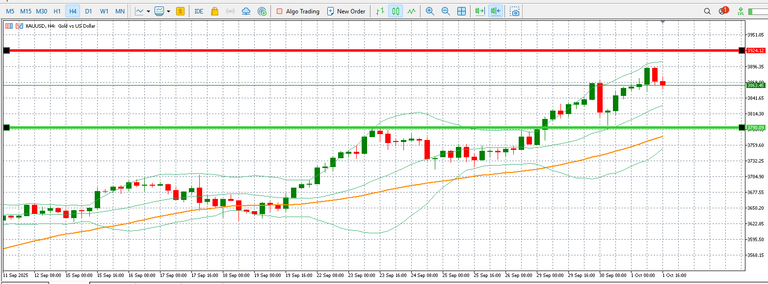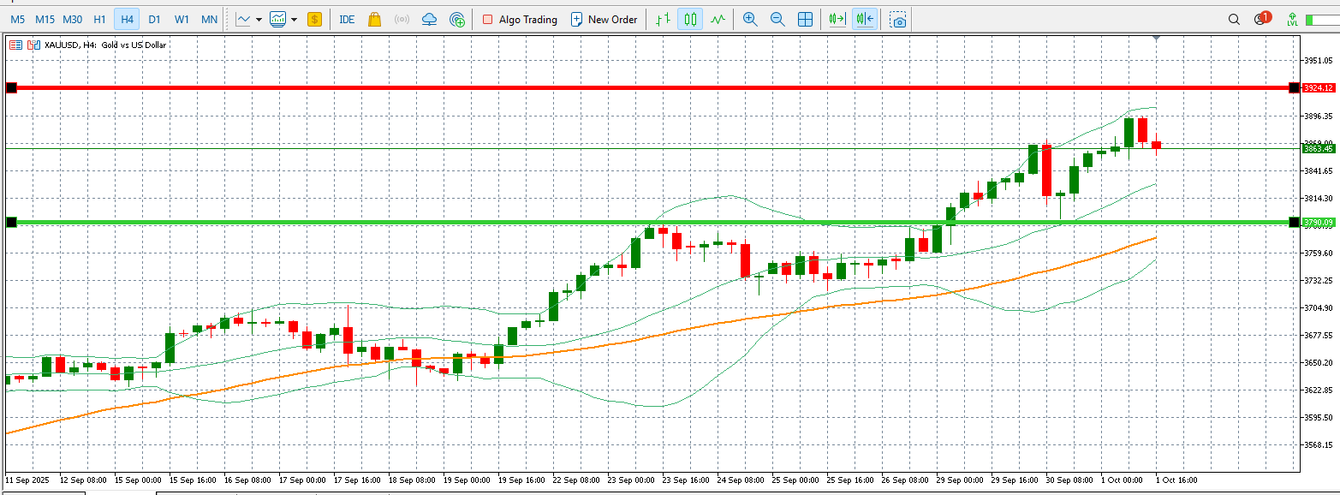Gold prices have continued their upward momentum, trading at $3,889.46 per ounce today, as market uncertainty, geopolitical tensions, and economic data flows converge to boost demand for safe-haven assets. A combination of aggressive political rhetoric, market volatility, and rising fears surrounding a potential U.S. government shutdown has injected a significant risk premium into the gold market.
U.S. ADP Data Impact on the Federal Reserve and Gold Prices
The U.S. ADP Non-Farm Employment Change for September showed a sharp decline of -32,000 jobs, far below the forecasted gain of 52,000. This stark deviation from expectations points to weakness in the labor market, fuelling concerns that the U.S. economy is slowing, which could prompt the Federal Reserve to adopt a more dovish stance in its next meeting. A slowing labour market diminishes inflationary pressures and may reduce the urgency for the Fed to continue its tightening cycle, making gold more attractive as the real yield on U.S. bonds could remain low or even turn negative.
The disappointing jobs data reinforces the narrative of an economy under pressure, with softening wage growth and worker hesitation contributing to a lack of inflationary wage pressures, further boosting the likelihood of a Fed pivot toward easing. If the Fed does choose to ease or pause its tightening cycle, gold would likely benefit from lower interest rates and a softer U.S. dollar, reinforcing its position as a safe-haven asset.
ISM Manufacturing Data and Its Impact on the U.S. Economy and Gold
The ISM Manufacturing PMI for September came in at 49.1, slightly higher than the forecasted 49.0, but still below the critical 50.0 threshold, indicating that the U.S. manufacturing sector remains in contraction. T
he ISM Manufacturing Prices Index stood at 61.9, signaling persistent inflationary pressures in the industrial sector, despite the broader slowdown. The combination of weak manufacturing output and rising prices suggests that while inflation is still present, the broader economy may be struggling to maintain growth.
This presents a mixed outlook for the Federal Reserve: if inflation continues to stay elevated in some sectors, the Fed may be less inclined to pivot aggressively on policy, but given the overall slowdown in manufacturing and the job market, market expectations for rate cuts may intensify.
In this environment, gold’s appeal as an inflation hedge and a safe-haven asset grows stronger. Should the U.S. economy continue to slow, with further weakness in manufacturing and jobs data, gold could continue to attract institutional inflows and retail investors alike, pushing prices higher as we head into the final quarter of the year.
The Shutdown Threat and Its Potential Impact on Gold Prices
The U.S. government shutdown is another critical factor weighing on investor sentiment. The Congressional Budget Office (CBO) estimates that a shutdown would result in the furlough of around 750,000 federal workers, causing a ripple effect in public services and economic activity.
As the shutdown drags on, markets are likely to experience heightened uncertainty, leading to more capital inflows into gold as investors seek to protect themselves from potential disruptions in government functions, including delays in key economic reports. The market’s perception of uncertainty and risk surrounding the political landscape is likely to drive demand for gold higher, particularly in the absence of reliable economic data.
If the shutdown lasts for an extended period, gold could become an even more attractive asset as a store of value amidst policy paralysis, continuing its rally into the final quarter of the year.
Technical Levels to Watch
The chart below shows important price levels for the price of the shinning metal which traders must keep an eye. The upward momentum seems to be still intact which means that any weakness in the price of gold is likely to remain an opportunity.

Gold Chart by XTB
Conclusion
In summary, gold’s price trajectory is being shaped by a blend of political turmoil, economic data surprises, and the threat of a U.S. government shutdown. With gold trading at $3,889.46 per ounce, investors are increasingly flocking to the metal as a safe-haven asset, anticipating both continued economic uncertainty and potential dovish policy shifts from the Federal Reserve.
